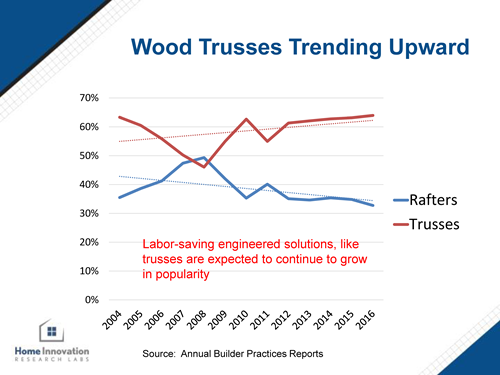

Ed Hudson, Home Innovation’s director of Market Research, gave the presentation linked below during the 2018 International Builders’ Show. It is a summary for manufacturers of building materials, and the content was based on our decades of experience in tracking this market and conducting research in support of new product introductions.

Source: Ed Hudson 2018 IBS presentation, "Trends and Opportunities in the U.S. Building Products Market"
With the inertia in the building industry, some aspects of home construction rarely change. We still build with lumber above-grade and concrete at- and below-grade level. We are primarily still using asphalt shingles, steel nails, fiberglass insulation, gypsum wallboard, and we use most of the same installation practices used in previous generations. Generally, the building materials market prefers evolutionary vs. revolutionary change. The market is highly competitive and its key players (contractors) are operating on tight margins and not inclined to bear the cost of change all by themselves. In order to be successful with a new product, a manufacturer has to make the benefit of switching very favorable for a contractor, while minimizing the difficulties involved while making the change.
On occasion, the industry is amenable to change. For example, in recent times nine feet has rapidly become the new standard wall height, and 2x6’s are used almost as often as 2x4’s for wall framing. Granite is the new standard countertop (though quartz is fast overtaking granite). And wood floors have become the most popular flooring for the main living areas, surpassing both carpeting and tile. But how do you know whether your product will be a success or failure? That’s the million-dollar question. While we don’t purport to have a crystal ball, this presentation sheds a little more light on what works and what doesn’t based on industry trends over the past decade. It provides insight into things manufacturers should—and, at least equally importantly, should not – do in their new product introductions.
Let us know if you have questions about the presentation’s content, or if you’d like to discuss trends in your product category specifically.